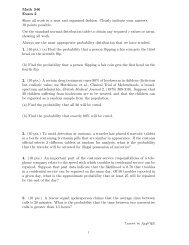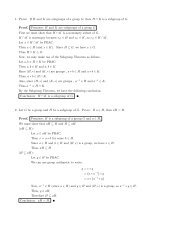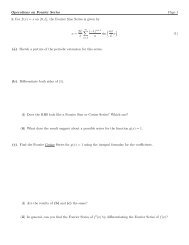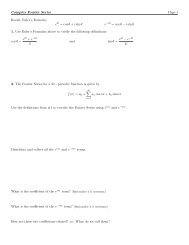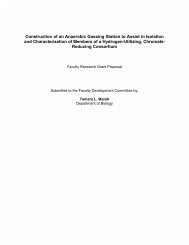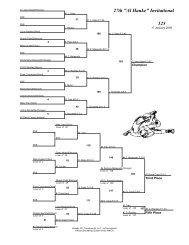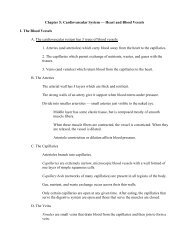Free Executive Summary - Elmhurst College
Free Executive Summary - Elmhurst College
Free Executive Summary - Elmhurst College
You also want an ePaper? Increase the reach of your titles
YUMPU automatically turns print PDFs into web optimized ePapers that Google loves.
Learning to Think Spatially: GIS as a Support System in the K-12 Curriculum<br />
http://www.nap.edu/catalog/11019.html<br />
SPATIAL THINKING IN EVERYDAY LIFE, AT WORK, AND IN SCIENCE 51<br />
Preliminary Assembly<br />
continued from page 2.<br />
Pin<br />
Set<br />
E. 1. Take the ball & downrod and loosen the set screw<br />
in the ball. Remove the pin and the ball from the downrod.<br />
(If you have a longer downrod, use it now.) See Fig. 3<br />
Fig. 3<br />
F.<br />
2. Feed the three wires from the top of the fan through the<br />
downrod and thread the downrod into the coupler. Align<br />
the holes in the downrod with the holes in the coupler.<br />
See Fig. 4<br />
3. Insert the threaded pin and tighten it and the set screw.<br />
4. Place the canopy around the downrod. Slide the ball<br />
onto the downrod and replace pin. See Fig. 5<br />
5. Raise the ball so that the pin is in the slot and tighten<br />
the set screw. See Fig. 6<br />
6. Make sure all of the screws are tight. At this time you may want to shorten the wires from the fan<br />
to 6" from the ball. This helps when you tuck the wires into outlet box.<br />
1. Insert the two (2) Canopy Screws into Hanging Bracket loosely. Fig. 7<br />
WARNING – To Reduce The Risk Of Fire, Electric Shock, Or Personal Injury<br />
Mount Fan To AN Outlet Box Marked “Acceptable For Fan Support” And Use<br />
The Mounting Screws Provided With The Outlet Box.<br />
2. Take the hanging bracket and secure it to the outlet box (marked Acceptable for Fan Support) using the mounting screws provided<br />
with the outlet box. Tighten them evenly. If you are mounting the fan directly to the building structure, use the wood screws provided,<br />
and secure to a joist.<br />
3. Make sure all of the wires are accessible and are not being pinched. Also, make sure the bracket doesn’t wobble.<br />
To begin with, the site of installation must be clear of any obstructions. Walls, cabinet or cupboard doors, and AC/heating<br />
vents (strong air currents will cause fan to wobble) are common obstructions.<br />
Also, you will need a securely mounted outlet box that is listed for fan support.<br />
Fig. 6<br />
Fig. 4<br />
The only tools you will need are: A medium Phillips screwdriver, common sense, and a little caution.<br />
FIGURE 3.1 A set of instructions for installing a ceiling fan. Note the appeal to common sense and caution.<br />
apartment. A trip to a supermarket to stock up on food for the refrigerator requires getting verbal<br />
driving directions from a neighbor, remembering and following them, and finding where things are<br />
located in a store that is organized in ways subtly different from the one that the family is used to.<br />
A written grocery list has to be mapped onto the floor plan of the supermarket in an efficient way.<br />
To amuse a younger child on the journey home, someone has to help her to put together pieces of<br />
a complex jigsaw puzzle. The journey home is complicated by the need to make a detour around<br />
construction that was not marked on the downloaded route map. It is also complicated by a flat tire:<br />
replacing it with the spare requires understanding the instructions on the side of the jack, removing<br />
the bolts and the wheel, and then tightening the bolts in the correct direction and sequence. Returning<br />
home, another son is asked to take over lawn mowing duties and has to find an efficient way to<br />
maneuver around flower beds and trees in the garden. The youngest child’s shoelace has come<br />
undone and there is yet another lesson in how to tie a shoelace properly, a double knot this time. The<br />
costume for the middle daughter’s school play has to be cut from fabric, fitted, and sewn by<br />
tomorrow’s dress rehearsal.<br />
Everyday life is impregnated with tasks that, on the surface, are routine and trivial. Viewed as<br />
problems requiring solutions, these tasks are far from trivial in nature. All of the tasks involve the<br />
Copyright © National Academy of Sciences. All rights reserved.<br />
Fig. 5<br />
Fig. 7



